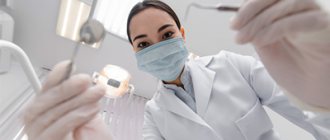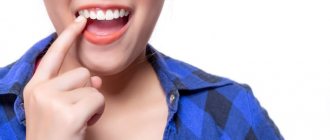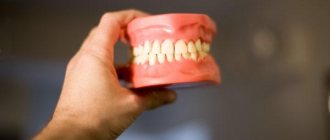Orthodontist Ageeva Olesya Pavlovna
, medical partner of Star Smile, St. Petersburg
Patient N came to my clinic complaining of a lack of space for the lower canine.
The patient is 21 years old, a sociable, positive, sociable young man.
The patient's main desire was the absence of braces in the oral cavity. The patient wanted the treatment to be as aesthetic and unnoticeable as possible; he said that he was not ready to walk like an “iron man” with iron structures in his mouth.
So, the task is not an easy one - not to turn the patient into Iron Man... Although the hero of the blockbuster of the same name Tony Stark evokes sympathy among many, we are talking about another comparison - the hero Willy Wonka as a child from the wonderful and kind film “Charlie and the Chocolate Factory”:
Before we look at the happy history of bite correction, let's touch a little on the bite problem itself, and what you should always pay attention to. Still, if you see crooked teeth, then it is important to understand some points that can and should be corrected so that there are no more problems with teeth and the temporomandibular joint in your future life.
A little theory:
Dentists, and especially we, orthodontists, very often use the term “Occlusion”, which is incomprehensible to many. Don't be alarmed, everything is very simple. I'll explain now.
Occlusion
- nothing more than the contact of the teeth of the upper and lower jaws.
In the modern world of dentistry, the understanding of occlusion is complex and includes the relationship of teeth, masticatory muscles and temporomandibular joints. And we always look at the bite precisely from the point of view of the function of the bite or its violation - bite dysfunction.
We consider occlusion as any contact between the incisal edges or chewing surfaces of the maxillary and mandibular teeth.
Why are these contacts between teeth so important?
Besides the fact that crooked teeth themselves look ugly and unaesthetic, but seriously, occlusion is very important in order to provide you with competent and optimal treatment. If you look carefully in the mirror at your teeth, at their contact with each other, you will see that the teeth have tubercles at the end, which are called fissure-tubercle contacts. And correct, stable occlusion is ensured by multiple uniform fissure-tubercle contacts of the lateral teeth, which are characterized by the presence of antagonistic cusp slopes on the occlusal surface of the contacts.
Cool and difficult with tuberculate contacts?
We’re done with the theory)) I’ll just note that correct occlusal contacts provide axial load on the teeth (we will see this in the photo of our patient), create stable central occlusion and eliminate overload of the tissues around the tooth - the periodontium.
For us orthodontists, occlusion is the central point of treatment, which should generally be aimed at optimizing the occlusal relationship of the patient's teeth with each other.
Molars are the 6th, 7th and 8th molars. Molars are also called molars, respectively. In the photo above it’s the molars. They perform the most important function in the human body - chewing and grinding food, which is why dentists often call them “chewing”. But the most harmful of the molars are the eights, or “wisdom teeth,” which can greatly harm the patient when they erupt.
So in this case, the “wisdom teeth” of the lower jaw had a fairly strong negative impact on the patient’s lower jaw, practically pushing the canine out of its place in the dentition. So, let's see.
External features of eye teeth
Eye teeth are visually very different from both the front teeth and molars. The eye tooth has only one root. It is relatively long and slightly flattened. The crowns of the eye teeth have two cutting edges located at an acute angle to each other. They also have a slightly flattened shape.
The upper eye teeth are noticeably larger and longer than the lower ones. Their cutting surface is much wider than that of the lower canines.
Nature entrusted these teeth to hold food in the mouth and tear food into pieces.
The patient had the following condition at the time of presentation:
In the case of our patient with a bite of molars “sixes” and “sevens” it is quite positive. The “eights” on the lower jaw were removed - it was their eruption that led to the displacement of the dentition and the appearance of such an unpleasant aesthetic imbalance in the patient’s smile. But everything can be fixed!
Displacement of the lower canines forward from the upper canines on the right and left
3rd class for canines on the right and left
Shift of the midlines due to the lower jaw to the right
Crowded position of teeth in the lower jaw
Lack of space for the lower right canine
And in general - narrowing of the dentition
Let me remind you that the main, basic desire of the patient is to avoid the presence of braces in the oral cavity.
As I wrote earlier, the patient wanted the treatment of crowded teeth to be as aesthetic and unnoticeable as possible, explaining that he was not ready to walk with glands in his mouth and be an “iron man” with iron structures in his mouth. Morally, at his young and active age, it’s hard, you’ll agree. After all, external, visible braces in this case are actually already “last century”, in the sense of technology of the last century, which has already been replaced by new, more advanced and effective technologies of the 21st century.
Based on the wishes of the young man, I proposed two options for treating crowded teeth and straightening canines using the following orthodontic equipment:
- Aligners
are transparent aligners, which are worn in the process of correcting the bite unnoticed by others. The aligners can be removed when eating and brushing your teeth.
- and lingual braces
- invisible braces that are attached to the inside of the teeth and are also not visible to others. But they are felt by the patient when worn. and removing lingual braces is not possible until the end of the entire treatment
Formation of eye teeth in children
Children's milk teeth erupt in a strictly defined sequence. Each tooth is waiting its turn to appear in the baby’s mouth.
Children's eye teeth begin to erupt only after all the incisors and first molars have appeared. The upper canines begin to erupt first. This usually happens at the age of one and a half years. The lower canines begin to appear when the baby is 20 months old.
This delay is explained by the fact that the roots of the eye teeth penetrate into the depths of the bone tissue much deeper than the other teeth.
During eye teething, children experience more than just pain. Most of them experience a slight increase in body temperature. Running noses and even swelling in the oral cavity often occur. Young mothers often perceive all this as a child’s illness. Meanwhile, this is a completely natural, albeit unpleasant, process. It cannot be any other way, because at this time the gums next to the baby’s teething teeth become inflamed.
Only in the rarest cases can babies experience coughing, diarrhea and even vomiting at this time. However, these are symptoms of another random disease that has nothing to do with the appearance of eye teeth.
As a result, the treatment option using aligners was unconditionally accepted
Why did the patient come to me with the problem of crowded lower teeth?
Still, my orthodontic experience is taking its toll, and recommendations are coming from grateful patients (thank them very much for this!). And in this case, the patient came on the recommendation of his sister, who was my patient several years ago with a very similar clinical situation in the oral cavity (narrowing, crowding of teeth nearby, slight crowding of teeth on the upper and lower jaws).
Did the patient know about the aligners?
Surprisingly, he was not motivated to get aligners. The patient knew about treatment with lingual braces (read on the Internet, saw it with friends), but he had never heard of treatment with aligners. I told him that there is a treatment method using transparent aligners (an alternative to braces), which need to be changed every 2 weeks. Aligners are more comfortable to get used to and wear than braces; oral hygiene does not suffer during treatment with aligners. And what is important, given how busy people are nowadays, is that the patient can visit the doctor less often than with braces. And as a decisive argument, when treating his crowded teeth with aligners, there will be no dietary restrictions.
Preparation for the treatment of crowded teeth is necessary in any case
The patient had already been examined by a therapist, treated all his teeth, cleaned them, understanding that he should have entered the treatment with normal teeth. The young man regularly visits a therapist once every six months (how rare is this to see), but nevertheless, the problem of dental aesthetics due to the incorrect position of the canine in the lower dentition began to grow.
The only additional thing that was done was teeth separation
. Separation is when we slightly carefully increase the interdental spaces by comfortable grinding, in a way that is safe for tooth enamel. During the entire period of treatment, five separations of incisors and premolars on the lower jaw were carried out due to crowding - to make room for the canine.
This is a very important point. And there is no need to be afraid of it, it is natural during the treatment process and absolutely comfortable.
Other treatments
| Another way to solve the problem is orthodontic treatment. This is true if the abnormal unit is located close to the dentition. Braces are usually used to straighten it, since this method is the most effective. The duration of treatment is determined individually, depending on individual characteristics. Orthodontic treatment may also be prescribed after the removal of a supernumerary tooth in order to normalize the bite. |
How was dental crowding treated with aligners?
To carry out a full course of treatment, 26 pairs of aligners were made for both jaws; treatment proceeded in parallel on both jaws, including the separation stages.
I immediately gave the patient 4 pairs of aligners; it is very easy to install them yourself - the patient needs to change them for new ones every two weeks.
Then he visited me only 2 months later. One of the previously mentioned interdental separations was carried out to help his canine, which had already begun to fall into place. And again, for a month and a half, the patient forgot about the doctor’s existence. But the doctor does not forget about the patient. This is the beauty of treatment with aligners - it is invisible to the patient)
What to do if there are no rudiments of permanent teeth, and baby fangs have not fallen out
In dentistry, there are rare pathologies, and there are quite common ones. One of the quite common ones is the absence of the rudiments of permanent teeth.
There are quite a lot of such patients who have lived almost to old age and accidentally learned that their fangs are actually milk teeth. Usually, the buds of permanent teeth gradually dissolve the roots of milk teeth and push them out.
And if there are no rudiments, then such a tooth can last for decades and only then begin to deteriorate. This is where it turns out that the tooth is a baby tooth, its root is defective and it is impossible to cover such a tooth with a crown. The milk tooth must be removed.
What to do in such cases? Under no circumstances should a fang be removed if it is standing straight! There are several other solutions.
- The baby tooth is removed and an implant is placed in its place. Today, this is the most competent option, which saves neighboring teeth from treatment for crowns and solves the problem once and for all.
- A much less competent option is a bridge prosthesis, when two adjacent teeth are ground down and a bridge is placed on them. This option is bad for at least two reasons. First, for a bridge you need to grind two innocent teeth, second, it is generally not recommended to include a fang in any bridge structures.
In one of these ways we solve the problem of a missing tooth. But in any case, we do not solve the aesthetic component completely in this way.
The fact is that the fang has one shape, and the incisor has a completely different shape. The canine that replaces the missing second incisor becomes a problem. For many, this is not too much of a tragedy, but some conventional girl, who has two vampire fangs sticking out instead of straight incisors, may be very worried about her appearance and look for ways to solve this problem.
In this case, the canine standing in the place of a two is converted into a two, and that’s it. You can also turn it into a deuce in several ways. It all depends on the specific situation, bite, shape of teeth, etc. and so on.
- Cosmetic restoration can be done using composite materials. It is fast, inexpensive, but not very durable and requires constant supervision by a dentist.
- You can install a veneer of the desired shape. The advantages are minimal processing of the enamel (if the shape of the fang allows it), good aesthetics, but expensive and not as reliable as a crown.
- Installation of a crown based on zirconium dioxide or metal-free (frameless). It is aesthetically pleasing, reliable, not too expensive, but sometimes requires quite strong tooth processing.
The fang itself must be much larger than the crown, plus it can erupt crookedly, bulge, stand at the wrong angle, etc. If orthodontic correction of its position is not carried out for some reason, then it will not be possible to turn it into a deuce without losses. You will have to depulp such a tooth (remove the nerve from it), sharpen it heavily, possibly correct the direction with a stump insert, and only then install a crown on it.
In general, in any case, you can find a way out of the situation. This pathology is far from the worst in dentistry, and there have long been ways to solve it competently and lastingly. You just need to find a good “your” dentist!
Let's smile together!
I want to tell you about such an important factor in treatment as emotions. If the attending physician, as a rule, always directs emotions in a positive direction, since correcting the patient’s bite is his profession, then for the patient, every moment of improvement in his current condition, or vice versa, every small anxious moment is a surge of emotions. That's right, because the patient begins a new life with a beautiful smile, and for him in this new life there is already a place for openness and positive impressions.
During treatment with aligners, as agreed, the patient very actively communicated with me using messengers.
What periods would I like to highlight in his emotions:
The first period of treatment for crowded teeth with aligners is “anxiety”
After installing the attachments and giving the patient the first set of aligners, I was faced with his slight anxiety about tooth sensitivity; the patient constantly asked me if it was normal that one or the other tooth was sensitive when biting (to which I replied that this was absolutely normal and this is a period of getting used to the aligners), but after the first week and the patient got used to the aligners, his anxiety also went away. Later, when changing each set of aligners to a new one, he was already calm about the slight sensitivity of his teeth in the first 2 days of wearing the new set.
The second period of treatment for the patient is “satisfaction, sharing impressions”
Subsequently, the patient was so pleased with the chosen treatment method that he constantly told me funny / incidental stories related to removing the aligners in a restaurant or on vacation, or brushing his teeth at work after eating:
- Once
I wrapped my aligners in a napkin in the cafeteria at work and they were taken away along with the tray and thrown away, the patient panicked, called me and asked what he should do?! I suggested either looking in the trash or ordering a new set, but in the end he, a colleague and a canteen worker found them in a trash container! HOORAY) - Second story
. I was on a business trip, went to a restaurant for lunch and didn’t take the container with me, took off the mouth guards before eating, put them on a napkin next to me (for some reason I took off the mouth guards right at the table), a family with children was sitting at the next table and the children began to laugh when they saw how he took off his mouthguards, telling his parents: “Look, the guy is taking off his dentures”:
After all, aligners are generally transparent and invisible
The third period of treatment for crowded teeth is “complete satisfaction”
Complete satisfaction is also supplemented by an assessment of how others perceive him - “how cool he is.” Yes, this is cool, treatment with aligners is invisible, aesthetic, every day it adds inner self-confidence to the patient, liberates the person and reveals his potential for communication with friends. This is really cool!
Fourth period of treatment. There is no more crowding of teeth: “I will be bored without aligners”
At the end of the treatment, the patient already said that he did not know how he would live after the aligners, that he would miss them and whether it was possible to continue wearing them after treatment. Do not take this literally, the patient just had a little anxiety - the fear of losing the result he was very satisfied with!
The patient began to smile and laugh much more often!
But this is important for me, as a treating orthodontist. The patient’s smile is the most important gratitude for my work.
Interesting moments that the patient described about the sensations on the aligners
The patient noted in the messenger that his tooth (fang) was moving and he was afraid to remove the aligner along with the fang! The movement of the canine as a result of removing crowding does occur, and as a result, tooth mobility can actually be felt. But since all dental movements during treatment with aligners are planned in advance, and the patient’s teeth are reliably protected in the aligners, all worries were removed.
As I told you earlier, once on a business trip in a restaurant, when he forgot the container and put the aligners next to him on a napkin, the children at the next table laughed that he had taken off his dentures
In fact, aligners can and should be stored in a special container while brushing your teeth or eating
Problems of treating crowded teeth with aligners
There were no problems at all with wearing the aligners. The only thing is that the activator came off once - this was after six months, but this was quickly eliminated and did not affect the course of treatment.
There was a case when a patient went on vacation and did not take his mouthguard retainer with him - his internal retainer came unstuck and the tooth moved back a little, “rotated” as orthodontists say. Now the problem is over.
Care
Immediately after growing the fangs, the dentist applies a special varnish to them. It provides protection. The layer helps prevent damage to the material from external factors (dyes, high temperatures). Dentists recommend growing fangs at the age of no earlier than 16-18 years.
Extended teeth require certain care. Compliance with hygiene rules and dentist recommendations will help avoid caries and other problems.
Recommendations:
- twice daily brushing of teeth;
- use of non-abrasive paste, soft and medium brush;
- refusal of coffee, smoking, strong brewed tea;
- regular preventive dental examinations, timely response to pathological symptoms.
My comment on this treatment:
I am satisfied with the result of the treatment and, probably, with the entire treatment process (even the slight anxiety and scrupulousness of the patient), it is nice to see in the end a satisfied, grateful and constantly laughing patient.
Now let’s imagine what would happen if the treatment of crowding began with lingual braces:
Yes, if the patient had rejected the aligners as a way to correct the bite, then, apparently, the choice would have fallen on lingual braces (considering that initially the patient did not want visible methods of correction)
When choosing lingual appliances as a treatment, I assume that the treatment would be more difficult for the patient.
Considering his increased anxiety and scrupulousness:
- he would not be able to get used to the violation of diction when wearing lingual braces (a lisp, which would definitely be present), and for him this would be a very important aspect associated with constant communication at work,
- he would not be satisfied with his oral hygiene, pain and discomfort when getting used to the braces system (more pronounced than the sensations with aligners),
- he would not be happy with the constant discomfort for his tongue.
Therefore, both the patient and I are very pleased with the aligners - our choice of treatment method and are satisfied with the results obtained!
Your orthodontist, Olesya Ageeva
Why canine extensions are performed, indications
Any adult has four fangs in his mouth - two at the top and two at the bottom. Visually, they are practically no different from other teeth. Some young people, fans of mysticism and the aesthetics of vampirism, turn to the dentist for fang extensions. The procedure allows them to bring their image closer to that of a vampire.
There are also certain medical indications for canine extensions. Only a dentist can prescribe such extensions. The technique is safe and can be performed by almost anyone. There are several ways to lengthen teeth, in most cases the direct method is used. The length of the extended tooth should not exceed 4 mm. It should be taken into account that an elongated tooth in the mouth can create discomfort and there is a risk of injury to the mucous membrane.
Indications for the procedure:
- therapy - extensions are carried out in case of chips or damage to the crown;
- aesthetic goal - whether there is a need to change the size or shape of the tooth;
- orthopedics - extension is carried out when a tooth is completely destroyed and needs to be restored.
The choice of augmentation technique depends on the indications.
Do you really need lingual braces to treat crowded teeth as your doctor advises?
Are you ready to carry this pile of iron in the form of braces - even cool lingual ones - in your mouth for the entire duration of treatment (a year or two)?
Rub your tongue against them, polish them until they shine, eliminating pieces of food? You will definitely be rubbing not covertly, but clearly, unpleasantly and constantly. Braces are uncomfortable and not aesthetically pleasing. You can have a high-quality consultation with our orthodontists and understand - what if your case of crowded teeth can be perfectly cured with aligners? If aligners can do it, then why subject yourself to self-torture with braces? So, we offer consultation on crowded teeth. Useful for you. The Star Smile company operates in more than 70 cities of Russia and will be able to offer you competent consultation with an orthodontist in your city.
Take the first step towards comfortable treatment.









